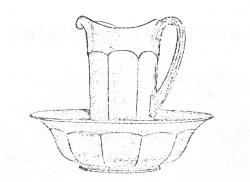Cambridge Rainbow - Azurite
by Lynn Welker
Issue 33 - January 1976
Hello and a belated Merry Christmas. My present to you this Christmas is the color azurite.
Azurite is a rich, deep blue milk glass. It does vary in color somewhat, especially in the depth of blue, sometimes with a white slag line running around the piece. Azurite was first introduced to the glass trade in 1922. The first production was started late in 1921. Azurite was the first of the brilliant opaque colors introduced by Cambridge (excepting Ebony). Production of Azurite ceased in the late 1920s as transparent glass took over in popularity from opaque glass.
Azurite production was almost solely in plain shapes with no pressed pattern, but what a wonderful variety of shapes in which it was produced. The following is a list of known shapes of Azurite: bowls in a myriad of sizes, shapes end depths, all available with or without Ebony bases as well as Ebony or matching Azurite flower frogs; compotes also available in a great variety of sizes, heights and shapes (the mayonnaise compotes could be had with matching Azurite ladles) plates in four sizes of 7 in., 8 in., 9 in. and 11 in., with or without indented rings to hold bowls or compotes; vases in many shapes, some of which set flat on the table, as well as some on a stem and foot.
Seven sizes of baskets were made in Azurite and ten different styles of candlesticks; some styles were produced in two different sizes. Covered candy boxes (with or without divided section) candy jars, ashtrays in several styles, divided and handled sweetmeat dishes covered mustards and marmalades (some with matching underplates) handled sandwich trays (both oval and round), a cheese compote and cracker plate with indentation to hold the compote, tumblers, sherbets, sugar and creamers, stoppered perfume bottles and atomizers (some are marked DeVilbiss on the bottom), and even a covered medicine tumbler and underplate round out the list of more unusual items made in plain Azurite.
 There are only three pressed
patterns in which Azurite was produced. The first is the Community
pattern (shown at left), again fairly plain but with panels
pressed down the sides. Available in Azurite in the pattern were mainly
boudoir and toilet items an overnight bottle and tumbler, various
shapes of covered powder boxes, several sizes of dresser trays,
including a small oval pin tray, candlesticks, several soap dishes
including a covered one, a toothbrush, holder (shaped like a tumbler)
and probably the most beautiful and desirable, a large washbowl and
pitcher set. What a Christmas present that would make !
There are only three pressed
patterns in which Azurite was produced. The first is the Community
pattern (shown at left), again fairly plain but with panels
pressed down the sides. Available in Azurite in the pattern were mainly
boudoir and toilet items an overnight bottle and tumbler, various
shapes of covered powder boxes, several sizes of dresser trays,
including a small oval pin tray, candlesticks, several soap dishes
including a covered one, a toothbrush, holder (shaped like a tumbler)
and probably the most beautiful and desirable, a large washbowl and
pitcher set. What a Christmas present that would make !
The second known Azurite pattern is the Doric pattern Ram's Head bowl and matching candlesticks (two styles or candlesticks were available). The third pattern may not have been a production pattern in Azurite. It is the Chelsea pattern, in which a small nappy bowl is known.
Pieces of Azurite that have not been seen but are shown on catalog pages of that period and may have possibly been made are: a water pitcher, goblets, cruets, a Water set tray, an ice tub, the Doric plate which matches the Ram's Head bowl, desk set articles and a cuspidor.
Although Azurite is a beautiful color undecorated, it was available with endless decorations. These decorations are not too common today as they were very susceptible to wear. Gold, platinum or black enamel bands as well as those with etched and encrusted gold, platinum or black enamel borders decorate many pieces. Among the more unusual etchings seen on Azurite are the Peacock, Dragon and the #521 Grape (all of these etchings have been seen on Azurite encrusted with black enamel or gold). Iridescent border trim overlaid with gold seaweed or wheat is an unusual decoration found on Azurite. A few Azurite bowls and compotes have been seen with an unusual, dark or purple or black stain on the outside surface. Be careful if you wash a piece of this as it comes off easily. A very few pieces of Azurite were decorated with a sponged acid finish on the exterior which gives the piece an ice or fern like appearance.
Very little Azurite is marked. The only known mold marked ![]() pieces are the 6 in. bulb bowl
and the small Community oval pin tray. The Azurite pieces with the
exterior stain often carry a
pieces are the 6 in. bulb bowl
and the small Community oval pin tray. The Azurite pieces with the
exterior stain often carry a ![]() and
"Made in U.S.A." on the bottom, done in the same color stain as the
decoration. A few rare pieces still carry the gold "Cambridge Art
Glass" label intact.
and
"Made in U.S.A." on the bottom, done in the same color stain as the
decoration. A few rare pieces still carry the gold "Cambridge Art
Glass" label intact.
Azurite was an important color to the Cambridge Glass Company, as it was one of their most successful early colors as well as a forerunner of their other beautiful opaque colors. Collect Azurite as a Christmas present to yourself all the year through.
